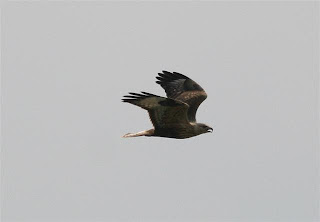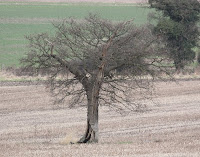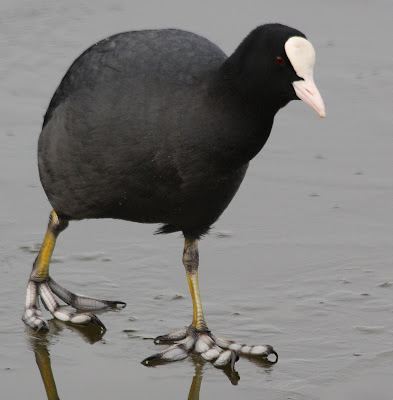 And once again, nearly the last bird seen was another Reed Bunting...I lost count but it was definitely their day.
And once again, nearly the last bird seen was another Reed Bunting...I lost count but it was definitely their day.Saturday 28 February 2009
Reed Buntings at Oare Marshes
 And once again, nearly the last bird seen was another Reed Bunting...I lost count but it was definitely their day.
And once again, nearly the last bird seen was another Reed Bunting...I lost count but it was definitely their day.Friday 27 February 2009
Memories #2 - Bulgaria Sept 2007

 Long-legged Buzzard
Long-legged Buzzard 

 Clockwise from top right - Lesser Whitethroat, Boleta Valley, Common Whitethroat, Bee-Eater, Thrush Nigtingale, Golden Oriole & Your Summer Hideaway!
Clockwise from top right - Lesser Whitethroat, Boleta Valley, Common Whitethroat, Bee-Eater, Thrush Nigtingale, Golden Oriole & Your Summer Hideaway!A massive fall of Sylvia warblers feeding on berries included 200+ Blackcap, 200+ Common Whitethroat, together with 50+ Lesser Whitethroats complemented by Spotted and Red-breasted Flycatchers, with Golden Orioles flying and calling overhead plus excellent views of two showy Thrush Nightingales located by James and Nikolay by their single note migration call which is very similar to that made by Common Nightingales. The experience was further enhanced with 8 Squacco Herons, a Ferruginous Duck, and Levant Sparrowhawk with the constant presence of Bee-Eaters and Alpine Swifts amongst the other hirrundines all around us. Everyone agreed that if you could pick a ‘local patch’ this site would be perfect with its wide mix of habitat and the gorge caves regularly holding a pair of breeding Eagle Owls. A dusk visit to a cliff face close to our hotel finally gave us a chance to scope an Eagle Owl perched high on the cliffs with another individual calling nearby but too dark to capture on film!

 The various Saltpans provided a list of around 30 shorebirds and waders including 50 Marsh Sandpipers, numerous Little Stints with a few Teminck’s; Kentish & Little Ringed Plovers; good views of 6 Broad-billed Sandpipers plus lots of Wood Sandpipers (40+), Curlew Sandpipers (50+), a few Green Sandpipers, and the usual Redshank, Greenshank, Ruff and Dunlin etc. in various plumages. We also enjoyed the constant calls of large numbers of Common and Sandwich Terns with over 100 Black Terns together with several Whiskered, Gull-billed and one juvenile White-winged Black Tern.
The various Saltpans provided a list of around 30 shorebirds and waders including 50 Marsh Sandpipers, numerous Little Stints with a few Teminck’s; Kentish & Little Ringed Plovers; good views of 6 Broad-billed Sandpipers plus lots of Wood Sandpipers (40+), Curlew Sandpipers (50+), a few Green Sandpipers, and the usual Redshank, Greenshank, Ruff and Dunlin etc. in various plumages. We also enjoyed the constant calls of large numbers of Common and Sandwich Terns with over 100 Black Terns together with several Whiskered, Gull-billed and one juvenile White-winged Black Tern. 
The pace of this tour was very relaxed and enabled us to enjoy the superb, mainly unspoilt scenery, although there was daily evidence of the coastal strip development with numerous buildings, hotels and apartments, under construction and I can only hope that the local population do not get left behind with the scale of tourist lead expansion that is being carried out. Food during our tour was typically local dishes including large salads with plenty of cheese (goat, sheep & cow or a combination according to Nikolay) and I also gained a liking for Bulgarian yogurt, something I thought would never happen! Whilst my final total was 170 including 15 ‘lifers’ the lasting impression will be the pleasure of watching visible migration, the scenery, the food and all in the company of a very experienced and friendly Sunbird (James) and Bulgarian (Nickolay)guides.
“Glabodarya Bulgaria”, I will return someday. (Watch out for "Memories of Bulgaria May 2008). FAB.
Monday 23 February 2009
Garden delights - Euphorbia & Hellebores.
Saturday 21 February 2009
Cetti's Warbler at Stoke Lake

Friday 20 February 2009
Thursday 19 February 2009
Birding by sound?
On the drive into work I got to thinking (disastrous I know at my age) that it's that time of year again when I start to wonder whether I can remember the calls of those migrant visitors (warblers in particular) that will be arriving throughout the spring. I have never found it easy to listen to a long list of sound recordings on tape or CD and then store this information in my brain for prompt recall. My tactic has always been to go out into the 'field', listen and then try to locate the songster and match the sound to the 'face'. Generally this works but I often wonder what I have missed. It's a bit like "phishing", for me it’s a bit hit and miss!
A few of my memories of 'birding by sound alone':
Some people seem to have a natural aptitude for bird sounds - I particularly recall an autumn pre-breakfast walk in Mid-Wales with DC and in the space of 10 minutes he ID various calls of at least 15 species and we hadn't seen a thing - that's why he is a professional and I'm a mere amateur.
I distinctly remember the first time I heard the glorious sound of a Nightingale, singing on a warm humid evening, surrounded by biting insects, on Bookham Common just after the sun had set. (But not seen!)
The next occasion was a week later when I heard a Nightingale singing from within woodland at Bookham Common. I slowly followed the sound and eventually located the individual perched fairly low down but in the open next to a well used path. For the next 20 odd minutes I watched and listened as this male belted out his song and with an ancient hand held Dictaphone I recorded his song while at least two dog walkers quietly passed by and were presumably totally unaware of what I was doing. I used this recording for a few years to introduce others to the sound of Nightingale as it tends to be a species that few actually see. Regretfully the tape has long since disappeared but the memory is still strong.
During recent annual 'Dawn Chorus' walks at work the first hour is birding virtually in the dark and just using your ears to listen whilst trying not to bump into any of the 30 visitors who have come to witness this event as we head into the gardens. The problem is everyone wants to know which birds are making every single sound! My normal response is to suggest that they stand quietly for a few minutes and just listen thereby enjoying the growing additions to this orchestral feast of sound - this actually gives me time to get my brain in gear before attempting to identify all the relevant species. I'm sure I've made a few bloomers over the years but nobody seems to mind.
On previous annual camping holidays to Sandringham in Norfolk we would lie awake waiting for the local Tawny Owls to start talking to one another interspersed with their well known and often repeated 'kewick' shrills. Memories of my first birding trip abroad to Mallorca are directly linked to the daylight calls of the Hoopoe (a trisyllabic & repeated 'oop-oop-oop') and the nightly sonar-like 'tyuh' of the resident (Eurasian) Scops Owls which can be heard, I believe, up to a kilometre away.
A trip with friends to Stodmarsh in late January a few years ago when it was so foggy you couldn't see more than 10 metres in front of you and most of the water was totally frozen. The comment was uttered "what the hell are we doing here in these conditions"? Well I said "you'll just have to use your ears, I can hear Ducks somewhere out there" and reeled off a few specie names. Who was going to argue? Actually it turned out to be the best day for Water Rail as we counted no less than 15 individuals seen and a few more heard throughout the day AND a sighting of Bittern if somewhat hidden by the moving fog. So it wasn't all bad despite the conditions - You just have to adapt.
Finally on my arrival at work two 'honking' Greylag Geese flew overhead. As I headed across the car park I was greeted by the sounds and sight of Blue, Great & Long-tailed Tits plus Chaffinches feeding as they worked their way through the Alders. A pair of Great-spotted Woodpeckers alighted on a nearby tree and followed each other from perch to perch and then quietly flew away together while a Nuthatch called from the edge of Battleston Hill and the resident Robins and Song Thrushes were announcing their prowess from various song posts. The last sound was the squawking call of two Rose-ringed Parakeets as they flew into the gardens.
So what are your experiences of 'birding by sound' AND do you have any tips for improving your memory in order to identify both common and migrant species?
Tuesday 17 February 2009
Cannine interruption!

So no bird photos just a few trees whose bark doesn't bite!
Saturday 14 February 2009
The Dunnock
 Some years ago during a walk with Dominic Couzens he explained the spicy sex life of the Dunnock (Hedge Accentor) that only came to light in the 1980's thanks to the hard work of Nick Davies working in the Cambridge Botanical Gardens. On our subsequent meetings Dominic has often challenged me to repeat the amazingly complex pattern of social and breeding behaviour, which he so eloquently describes in his book "Birds - A Complete Guide to all British & European Species". So here goes.......
Some years ago during a walk with Dominic Couzens he explained the spicy sex life of the Dunnock (Hedge Accentor) that only came to light in the 1980's thanks to the hard work of Nick Davies working in the Cambridge Botanical Gardens. On our subsequent meetings Dominic has often challenged me to repeat the amazingly complex pattern of social and breeding behaviour, which he so eloquently describes in his book "Birds - A Complete Guide to all British & European Species". So here goes....... Dunnock breeding behaviour has evolved into an amazing melange of systems, with them exhibiting monogamy, polygyny, polyandry and polygynandry, and any individual may embark any one of these possibilities during the breeding season, sometimes even changing its arrangements in between broods. Firstly it is important to understand that there are usually fewer females than males so it is the females that skirmish over territories in the spring and once border disputes are settled the occupiers make it known that the services of the males are required. The feminine territories are generally larger than most males can cope with so males have to enlist the help of another to keep the boundaries safe - the two may share singing posts and give the impression of teamwork. However, they are actually in competition for the females favours and an awkward hierarchy develops with one male nominally dominant (alpha-male) over the subordinate (beta-male) but the female takes no notice of this and is more than willing to copulate with the beta-male (behind the back of the alpha-male) because the males fathering a brood sign a contract to provide parental care in proportion to their mating success. In this polyandrous trio, three birds contribute to feeding the young.
Dunnock breeding behaviour has evolved into an amazing melange of systems, with them exhibiting monogamy, polygyny, polyandry and polygynandry, and any individual may embark any one of these possibilities during the breeding season, sometimes even changing its arrangements in between broods. Firstly it is important to understand that there are usually fewer females than males so it is the females that skirmish over territories in the spring and once border disputes are settled the occupiers make it known that the services of the males are required. The feminine territories are generally larger than most males can cope with so males have to enlist the help of another to keep the boundaries safe - the two may share singing posts and give the impression of teamwork. However, they are actually in competition for the females favours and an awkward hierarchy develops with one male nominally dominant (alpha-male) over the subordinate (beta-male) but the female takes no notice of this and is more than willing to copulate with the beta-male (behind the back of the alpha-male) because the males fathering a brood sign a contract to provide parental care in proportion to their mating success. In this polyandrous trio, three birds contribute to feeding the young. Valentines Day - Another garden 1st.
 Not long after I returned indoors the birds decided to return and gorge themselves on the available food; Collared Doves (4), Feral Pigeons (2), Starlings (5); Great Tits (2), Blue Tits (2) plus evidence of courtship with food passing from beak to beak; Blackbirds (2); Magpies (2) but didn't stop long thankfully; Greenfinches (6); Long-tailed Tits (2) - same pair returning regularly; Robin (2); Goldcrest (1); Rose-ringed Parakeets (2); House Sparrows (male & female) and the pair of Dunnocks also returned. A definite pattern here on Valentines Day!
Not long after I returned indoors the birds decided to return and gorge themselves on the available food; Collared Doves (4), Feral Pigeons (2), Starlings (5); Great Tits (2), Blue Tits (2) plus evidence of courtship with food passing from beak to beak; Blackbirds (2); Magpies (2) but didn't stop long thankfully; Greenfinches (6); Long-tailed Tits (2) - same pair returning regularly; Robin (2); Goldcrest (1); Rose-ringed Parakeets (2); House Sparrows (male & female) and the pair of Dunnocks also returned. A definite pattern here on Valentines Day!Thursday 12 February 2009
The Coot





